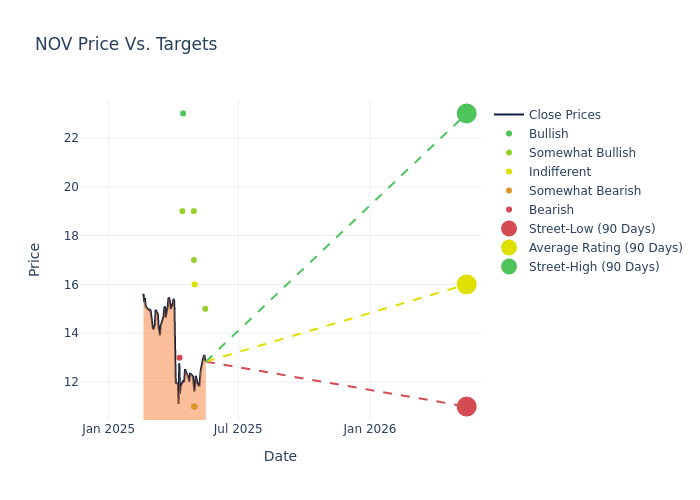NOV Stock: A Deep Dive Into Analyst Perspectives (11 Ratings)
11 analysts have shared their evaluations of NOV (NYSE:NOV) during the recent three months, expressing a mix of bullish and bearish perspectives.
The following table summarizes their recent ratings, shedding light on the changing sentiments within the past 30 days and comparing them to the preceding months.
| Bullish | Somewhat Bullish | Indifferent | Somewhat Bearish | Bearish | |
|---|---|---|---|---|---|
| Total Ratings | 1 | 5 | 1 | 3 | 1 |
| Last 30D | 0 | 1 | 0 | 0 | 0 |
| 1M Ago | 0 | 2 | 1 | 2 | 0 |
| 2M Ago | 1 | 2 | 0 | 0 | 1 |
| 3M Ago | 0 | 0 | 0 | 1 | 0 |
In the assessment of 12-month price targets, analysts unveil insights for NOV, presenting an average target of $16.27, a high estimate of $23.00, and a low estimate of $11.00. A 8.23% drop is evident in the current average compared to the previous average price target of $17.73.

Breaking Down Analyst Ratings: A Detailed Examination
A clear picture of NOV's perception among financial experts is painted with a thorough analysis of recent analyst actions. The summary below outlines key analysts, their recent evaluations, and adjustments to ratings and price targets.
| Analyst | Analyst Firm | Action Taken | Rating | Current Price Target | Prior Price Target |
|---|---|---|---|---|---|
| Elizabeth Porter | Morgan Stanley | Lowers | Overweight | $15.00 | $18.00 |
| Roger Read | Wells Fargo | Raises | Underweight | $11.00 | $10.00 |
| Luke Lemoine | Piper Sandler | Lowers | Neutral | $16.00 | $18.00 |
| David Anderson | Barclays | Lowers | Underweight | $11.00 | $13.00 |
| Arun Jayaram | JP Morgan | Lowers | Overweight | $17.00 | $20.00 |
| Keith Mackey | RBC Capital | Lowers | Outperform | $19.00 | $20.00 |
| Stephen Gengaro | Stifel | Lowers | Buy | $23.00 | $25.00 |
| Charles Minervino | Susquehanna | Lowers | Positive | $19.00 | $21.00 |
| Neil Mehta | Goldman Sachs | Lowers | Sell | $13.00 | $16.00 |
| Keith Mackey | RBC Capital | Maintains | Outperform | $22.00 | $22.00 |
| David Anderson | Barclays | Raises | Underweight | $13.00 | $12.00 |
Key Insights:
- Action Taken: Responding to changing market dynamics and company performance, analysts update their recommendations. Whether they 'Maintain', 'Raise', or 'Lower' their stance, it signifies their response to recent developments related to NOV. This offers insight into analysts' perspectives on the current state of the company.
- Rating: Analysts assign qualitative assessments to stocks, ranging from 'Outperform' to 'Underperform'. These ratings convey the analysts' expectations for the relative performance of NOV compared to the broader market.
- Price Targets: Gaining insights, analysts provide estimates for the future value of NOV's stock. This comparison reveals trends in analysts' expectations over time.
To gain a panoramic view of NOV's market performance, explore these analyst evaluations alongside essential financial indicators. Stay informed and make judicious decisions using our Ratings Table.
Stay up to date on NOV analyst ratings.
Unveiling the Story Behind NOV
NOV (formerly National Oilwell Varco) is a leading supplier of oil and gas drilling rig equipment and products, such as downhole tools, drill pipe, and well casing. The company operates on a global scale, with international markets contributing nearly two thirds of its annual revenue.
Understanding the Numbers: NOV's Finances
Market Capitalization Analysis: Below industry benchmarks, the company's market capitalization reflects a smaller scale relative to peers. This could be attributed to factors such as growth expectations or operational capacity.
Revenue Challenges: NOV's revenue growth over 3M faced difficulties. As of 31 March, 2025, the company experienced a decline of approximately -2.41%. This indicates a decrease in top-line earnings. As compared to competitors, the company encountered difficulties, with a growth rate lower than the average among peers in the Energy sector.
Net Margin: NOV's net margin is below industry standards, pointing towards difficulties in achieving strong profitability. With a net margin of 3.47%, the company may encounter challenges in effective cost control.
Return on Equity (ROE): NOV's ROE is below industry standards, pointing towards difficulties in efficiently utilizing equity capital. With an ROE of 1.14%, the company may encounter challenges in delivering satisfactory returns for shareholders.
Return on Assets (ROA): NOV's ROA falls below industry averages, indicating challenges in efficiently utilizing assets. With an ROA of 0.65%, the company may face hurdles in generating optimal returns from its assets.
Debt Management: NOV's debt-to-equity ratio is below the industry average. With a ratio of 0.37, the company relies less on debt financing, maintaining a healthier balance between debt and equity, which can be viewed positively by investors.
Analyst Ratings: What Are They?
Analysts are specialists within banking and financial systems that typically report for specific stocks or within defined sectors. These people research company financial statements, sit in conference calls and meetings, and speak with relevant insiders to determine what are known as analyst ratings for stocks. Typically, analysts will rate each stock once a quarter.
Beyond their standard evaluations, some analysts contribute predictions for metrics like growth estimates, earnings, and revenue, furnishing investors with additional guidance. Users of analyst ratings should be mindful that this specialized advice is shaped by human perspectives and may be subject to variability.
Which Stocks Are Analysts Recommending Now?
Benzinga Edge gives you instant access to all major analyst upgrades, downgrades, and price targets. Sort by accuracy, upside potential, and more. Click here to stay ahead of the market.
This article was generated by Benzinga's automated content engine and reviewed by an editor.